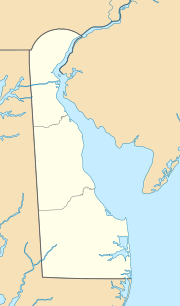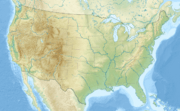Blanco Ditch facts for kids
Quick facts for kids Blanco Ditch |
|
|---|---|
| Other name(s) | Tributary to Sewell Branch |
| Country | United States |
| State | Delaware |
| County | Kent |
| Physical characteristics | |
| Main source | Jordan Branch divide about 0.5 miles east of Pearsons Grove, Delaware 67 ft (20 m) 39°13′49″N 075°44′03″W / 39.23028°N 75.73417°W |
| River mouth | Sewell Branch about 1.5 miles north of Pearsons Grove, Delaware 39 ft (12 m) 39°14′46″N 075°45′01″W / 39.24611°N 75.75028°W |
| Length | 1.40 mi (2.25 km) |
| Basin features | |
| Progression | northwest |
| River system | Chester River |
| Basin size | 0.75 square miles (1.9 km2) |
| Tributaries |
|
| Bridges | Sewell Branch Road |
Blanco Ditch is a small stream, about 1.40 miles (2.25 km) long, located in Kent County, Delaware. It's a "first-order tributary," which means it's a small stream that flows into a larger one. Blanco Ditch eventually joins Sewell Branch.
What is Blanco Ditch?
Blanco Ditch is a natural waterway that helps carry water across the land. It's an important part of the local water system in Delaware. Even though it's small, it plays a role in how water moves through the area.
Where Does it Start and End?
Blanco Ditch begins in an area called the Jordan Branch divide. This is a slightly higher piece of land that separates where water flows. Its starting point is about half a mile east of a place called Pearsons Grove, Delaware.
From there, the ditch flows generally towards the northwest. It travels for about 1.40 miles (2.25 km) before it reaches its end. Blanco Ditch flows into Sewell Branch, which is a larger stream. This meeting point is about 1.5 miles north of Pearsons Grove.
The Land Around the Ditch
The area of land that drains water into Blanco Ditch is called its watershed. This watershed covers about 0.75 square miles (1.94 square kilometers). This means all the rain and water that falls in this specific area will eventually flow into Blanco Ditch.
The land around Blanco Ditch gets a good amount of rain each year, about 44.7 inches (113.5 cm) of precipitation. A small part of this land, about 3.9%, is covered by forests. These forests help to filter the water and provide homes for wildlife.



